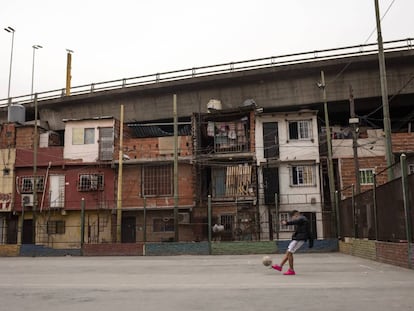Southern slums show flip side of ‘wealthy’ Buenos Aires
Capital of Argentina a tale of two very different cities as rampant inflation bites


Buenos Aires is the richest region in Argentina, but you would be forgiven for not noticing that it if you visited the city’s deep south. Here, away from the tourist sights and the glamor, locals live in squalor along the Riachuelo River, the country’s most polluted waterway. One of these residents is Nilsa, who lives with her three children in a room in a slum dwelling that costs her 1,500 pesos – or just under $100 – a month. Their home has no running water.
Nilsa has been a single mother since her husband died. She has been out of work for three months now, the first time this has happened since she arrived in the city from Paraguay five years ago. Her life is light years away from the city’s north where – just 10 kilometers away – people will stump up as much as $5,000 monthly rent for a luxury apartment.
Official statistics highlight the deep divide between the two sides of the Argentinean capital. The average income in Recoleta, the city’s most-affluent neighborhood, is double that seen in the poorest commune, which is made up of the shanty towns of Villa Lugano, Villa Soldati and Villa Riachuelo. A child born in the south is twice as likely to die before the age of five as one born in Recoleta.
A child born in the city’s poor south is twice as likely to die before the age of five as one born in upscale Recoleta
The life of that child’s parents is also likely to be very different in the city’s south. The unemployment rate for the head of the household is three times higher in the city’s poor southern neighborhoods, while the likelihood of that person having finished primary school is eight times lower.
But not everyone is keeping silent about this rampant inequality in the capital of a country where one in three people live in poverty. Two activists groups – the Frente Popular Darío Santillán and the Frente Popular Barrios de Pie – recently took to the streets and marched 20 kilometers to promote better housing and work opportunities for the city’s most disadvantaged residents.
That walk took them from the landmark obelisk in downtown Buenos Aires to the poor neighborhood of Villa Soldati. It saw them leave behind the bookshops and theaters the city is famous for and enter a world of trash-strewn streets without cinemas or clothing shops, or even ATMS and cafés. And that was without even entering the city’s slums, 17 of which lie south of the city’s 25 de Mayo highway, and whose presence is a constant reminder of Argentina’s last military dictatorship.
In the slums there are homes without running water or toilets and power cuts are a regular occurrence. Ambulances won’t enter unless they have a police escort and schools are in short supply.
To make matters worse, rampant inflation of 40% year on year has aggravated the situation in these areas in recent months. Although people living in the slums of Buenos Aires don’t pay for electricity and enjoy subsided public transport, prices here are actually higher than in other parts of the city, with meat now reserved for special occasions.
There are almost no odd jobs anymore and the soup kitchens are getting fuller all the time Villa Lugano resident
“We are living on noodles and rice, which is really dull. I used to be able to afford steak from time to time but not anymore,” says Vanesa, who lives in the Barracas neighborhood.
Residents are also feeling the pinch because of the flow-on effect of the rocketing prices of basic services such as gas and electricity. These price hikes have burned a hole in the pocket of the country’s middle class who in turn are hiring fewer bricklayers and cleaners from among the city’s poorer residents.
“There are almost no odd jobs anymore and the soup kitchens are getting fuller all the time,” says Viviana from the Villa Lugano neighborhood.
Then there are the long-term problems, such as the shortage of hospitals. In District 8, there are none. In Villa Lugano, work stopped on what was going to be the biggest hospital in Latin America back in 1955 and never restarted. And while Villa Soldati’s Cecilia Grierson hospital finally opened in 2009, it still functions only as a health center and has no ICU unit or beds for inpatients.
In an area where fewer than half of all residents have health insurance, emergency services are still 40 minutes away by bus.
The government led by reform-minded president Mauricio Macri has promised to equip the Cecilia Grierson with 100 beds but work is slow and is not expected to be completed by 2020. Just meters away from the hospital’s construction site, meanwhile, builders are rapidly putting up housing for athletes participating in the Buenos Aires 2018 Youth Olympic Games.
English version by George Mills.
Tu suscripción se está usando en otro dispositivo
¿Quieres añadir otro usuario a tu suscripción?
Si continúas leyendo en este dispositivo, no se podrá leer en el otro.
FlechaTu suscripción se está usando en otro dispositivo y solo puedes acceder a EL PAÍS desde un dispositivo a la vez.
Si quieres compartir tu cuenta, cambia tu suscripción a la modalidad Premium, así podrás añadir otro usuario. Cada uno accederá con su propia cuenta de email, lo que os permitirá personalizar vuestra experiencia en EL PAÍS.
¿Tienes una suscripción de empresa? Accede aquí para contratar más cuentas.
En el caso de no saber quién está usando tu cuenta, te recomendamos cambiar tu contraseña aquí.
Si decides continuar compartiendo tu cuenta, este mensaje se mostrará en tu dispositivo y en el de la otra persona que está usando tu cuenta de forma indefinida, afectando a tu experiencia de lectura. Puedes consultar aquí los términos y condiciones de la suscripción digital.
More information
Archived In
Últimas noticias
Maduro pleads not guilty before the federal court in New York: ‘I am still the president of Venezuela’
A new test can detect Alzheimer’s from a finger prick
UN team enters Sudanese city of El Fasher after paramilitary massacre: ‘It’s like a ghost town’
A recipe for resistance: Indigenous peoples politicize their struggles from the kitchen
Most viewed
- Gilles Lipovetsky: ‘If you want to live better and fall in love, take Prozac, don’t look to philosophy’
- Alain Aspect, Nobel laureate in physics: ‘Einstein was so smart that he would have had to recognize quantum entanglement’
- Maduro’s downfall puts China’s relationship with Venezuela to the test
- Why oil has been at the center of Venezuela-US conflicts for decades
- Alvin Hellerstein, a 92-year-old judge appointed by Bill Clinton, to preside over Maduro’s trial in New York










































